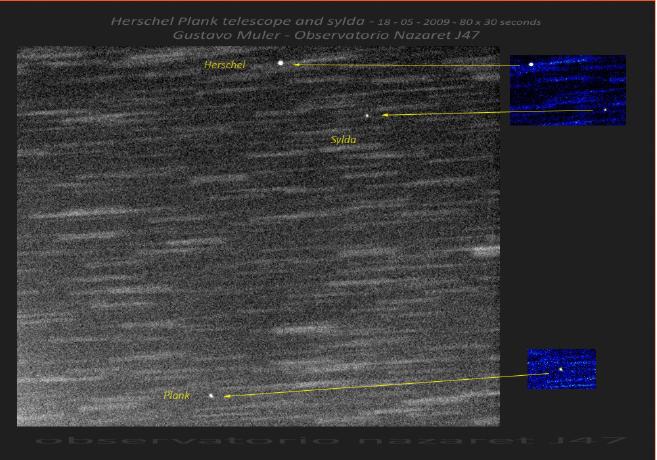Where is Herschel?
Herschel is moving almost directly away from the Sun towards L2 and thus nearly directly away from us, so it does not move rapidly across the sky, even though it is still moving quite quickly through space. At midnight Universal Time (GMT) on launch day it was still going at an impressive 2.29km/s, having separated at 9.7km/s. Tonight, its speed has dropped to a more sedate 0.70km/s. At 699 000km distance signals now take 2.3 seconds to reach the satellite from Earth.
Based on the predicted orbit, Herschel will reach its greatest distance from Earth on the morning of July 7th, when it will be at a distance of 2.28 million kilometers. From then on it will start to get closer again until September 5th when it will have closed to a mere 1.25 million kilometres, finally settling into an orbit about L2 with a 6-month period.
Tonight Herschel is close to Right Ascension 16h17m, Declination -02° 35' in the constellation of Serpens Caput, about 3.5 degrees south of the magnitude 4.8 star Sigma Serpentis.
However, if you want to find Herschel, it is getting quite faint now, as it is getting close to magnitude 17. You can still see it though quite easily with a 20-cm telescope and a CCD, as the image below shows.

This image shows Herschel, Planck and the Sylda, observed from his back yard observatory in Lanzarote by the Argentinian amateur astronomer Gustavo Muler on the night of May 18/19th, with a 30-cm telescope + CCD. The telescope tracked on the satellites, so you see the stars as long trails crossing the field of view. This image was composed of 80 exposures of 30 seconds each.
You can calculate an ephemeris for Herschel for your location in the JPL Horizons system: http://ssd.jpl.nasa.gov/horizons.cgi
Enter "Herschel Space Observatory" as the target name.
[M. Kidger from HSC ESAC, posted 20 May 2009]



0 comments:
Post a Comment